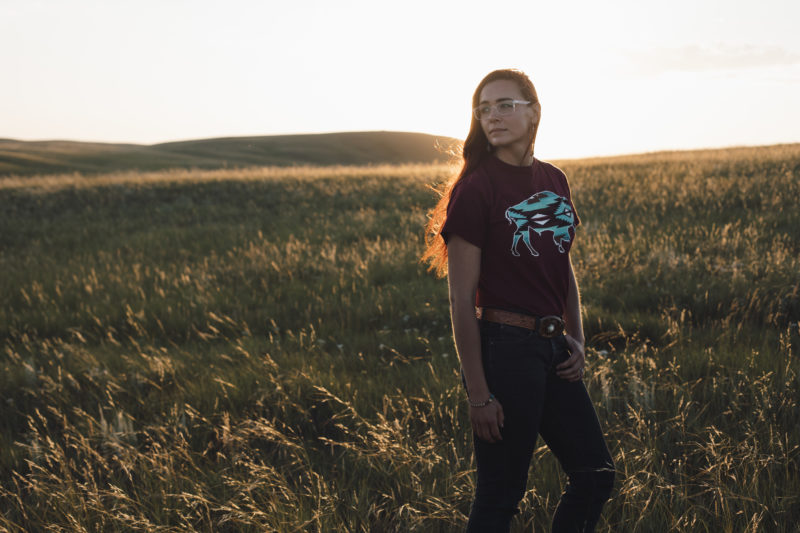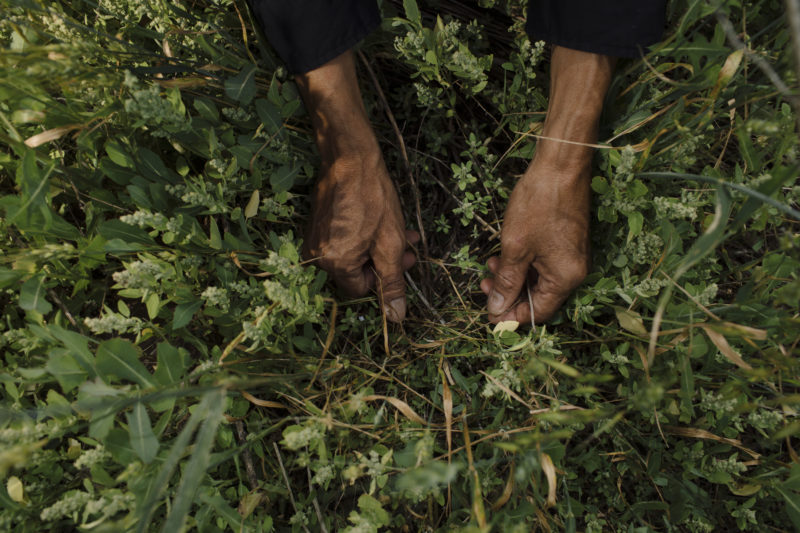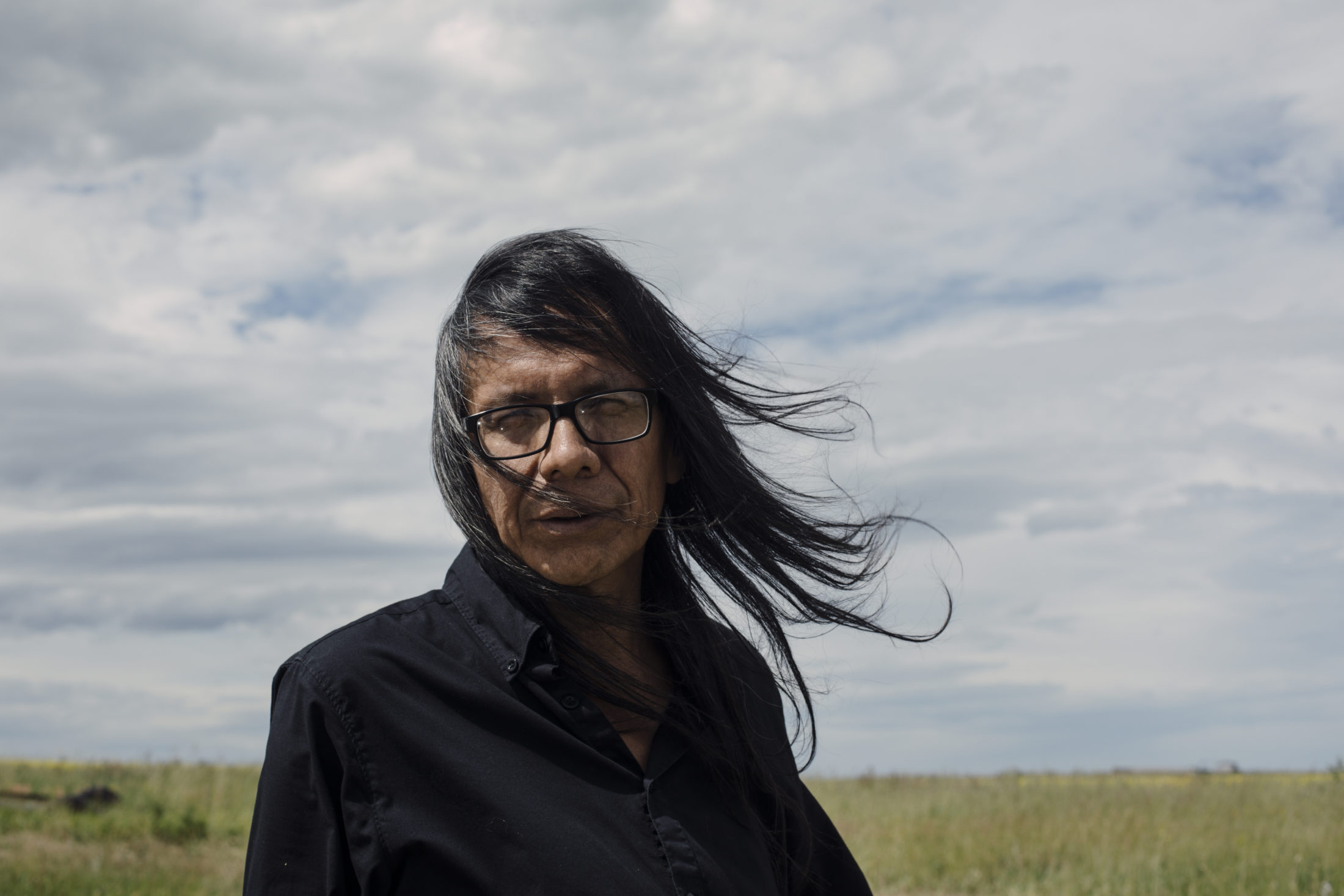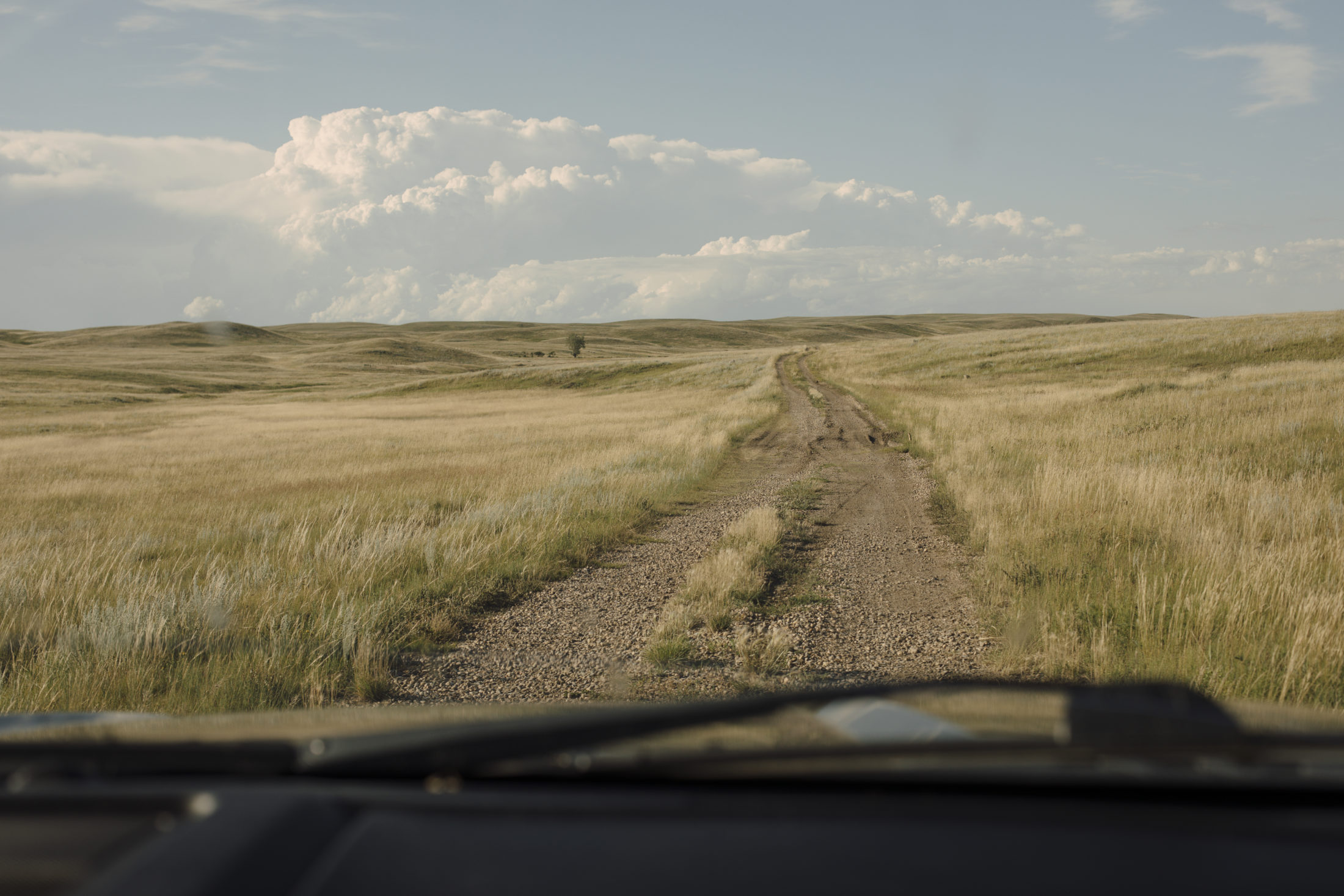
Ontario’s public service heads back to the office, meaning more traffic and emissions
For 15 years and counting, my commute from Mississauga to Toronto has been mired by...
This is the third part of Carbon Cache, an ongoing series about nature-based climate solutions.
It’s home to bears, elk, coyotes and birds, as well as people. It sequesters millions of tonnes of carbon. It’s taken millennia to become so biodiverse. It’s one of the most endangered ecosystems on the planet.
It’s not the rainforest. It’s the grasslands.
“In the prairie around here, it doesn’t look like much,” said Kansie Fox from Kainai Nation / The Blood Tribe, part of the Blackfoot Confederacy.
“You go out there, it just looks like grass.”

Kansie Fox in her backyard in Lethbridge, Alta. Photo: Amber Bracken / The Narwhal
But if you spend more time in the grasslands, you begin to see the life that exists, she said. Hundreds of plant species and more than 60 species at risk in Canada depend on grasslands. People also depend on the land. Kainai Nation citizens harvest medicine plants, hunt and hold ceremonies. Ranchers’ livelihoods depend on rich soil and healthy plants.
In the face of climate change, grasslands also have a major role to play in sequestering carbon, storing as much as 180 tonnes of carbon per hectare, equivalent to the annual emissions of 39 cars. (A hectare is slightly smaller than a Canadian football field.)
Some estimate the uncultivated grasslands of Western Canada may store two to three billion tonnes of carbon.

The original extent of Canada’s native prairie grasslands. Between 75 and 90 per cent of the grasslands have been eradicated. Map: Alicia Carvalho / The Narwhal
And more attention is being paid to that carbon after a study published in 2017 found nature-based climate solutions could provide up to one-third of emissions reductions needed under the Paris Accord, which intends to keep global temperature increases below 2 C.
“If you’re serious about greenhouse gas reductions, you have to make considerations for nature-based solutions,” said Bryan Gilvesy, CEO of ALUS Canada, a charity that works with farmers to restore habitat on their land. The charity helps farmers enhance the “ecosystem services” the land provides, such as clean air, clean water, carbon sequestration, flood mitigation and wildlife habitat.
“You get so much leverage out of nature-based solutions, whereby you sink carbon using nature, you create habitat for at-risk species, you create resilience because you manage floods better, you filter water because of the extensive root systems these plants have — you get a whole broad suite of benefits,” he said.

Dry mix grass prairie on the Lomond Grazing Association lease in southern Alberta. The grazing reserve harbours untilled native prairie, as well as wetlands, and is a refuge for many endangered species. Photo: Amber Bracken / The Narwhal
The problem is, when grasslands are cultivated they lose up to half of their stored carbon and stop offering these ecosystem benefits.
Over the past 150 years, between 75 and 90 per cent of Canada’s grasslands have been eradicated for agriculture and other development including roads, towns and industry.
Much like old-growth forests, these grasslands can’t be replaced because they developed slowly over thousands of years.
“One inch of topsoil takes about 500 to 1,000 years of building. That same one inch can be lost in a generation of mismanagement,” said Mickenzie Plemel-Stronks, cattle industry liaison for Ducks Unlimited Canada.
And a lot of life and carbon sequestration happens far beneath the surface of the grasslands and is still a mystery to humans.
“We don’t fully understand all of the components that are essential for the soil ecosystem. We can’t repair it if we don’t know what existed before it was broken,” she said.
After decades of destruction, people like Fox and Plemel-Stronks are taking things into their own hands to preserve the native grasslands that are left and bring the damaged land back from the brink.

Mickenzie Plemel-Stronks is the cattle industry liaison for Ducks Unlimited Canada. Photo: Amber Bracken / The Narwhal

Plemel-Stronks says one inch of topsoil takes about 500 to 1,000 years of building. Photo: Amber Bracken / The Narwhal

Plemel-Stronks on the Lomond Grazing Association lease in southern Alberta. Photo: Amber Bracken / The Narwhal
Plemel-Stronks said two hectares of grasslands can be home to more than 100 plant species, in addition to endangered species like the black-footed ferret and swift fox.
Grasslands are also turning out to be one of the most resilient ecosystems to climate change.
The secret of the tremendous carbon storage potential of grasslands is in its roots, which extend for metres below the ground.
“Most of the carbon in a grassland is actually underground,” said Silke Nebel, vice-president of conservation and science at Birds Canada. “This is important because when a fire comes, the carbon in a forest goes up in flames. But when a fire goes across a grassland, most of the carbon is still there.”
Plemel-Stronks added that grasslands are “great flood mitigators,” absorbing rain and slowing runoff velocity.
Despite their many ecological benefits, for many years government policy has encouraged cultivating grasslands instead of preserving them.
The 1872 Dominion Lands Act was meant to encourage settlement in the prairies and gave farmers 160 acres (65 hectares) for free as long as they agreed to cultivate at least a quarter of the land — and as long as they were over 21 years old and a man.
“That was the start of it all,” Plemel-Stronks said. “The act forced the conversion of a large area of land.”
Carolyn Callaghan, a senior conservation biologist at the Canadian Wildlife Federation, told The Narwhal that Canada has a poor inventory of its grasslands because there hasn’t been enough focus on them.
“They’ve kind of been forgotten about,” Callaghan said. “But it’s the most threatened ecosystem terrestrially in Canada.”

Mickenzie Plemel-Stronks walks on a trail of in the prairie grass in southern Alberta. She notes that grasslands are “great flood mitigators.” Photo: Amber Bracken / The Narwhal

Otskaapistsisskitsi, or prairie aster, flowers grow among brome grass and leafy spurge (yellow). Photo: Amber Bracken / The Narwhal

Yarrow, or Achillea millefolium, in southern Alberta. Photo: Amber Bracken / The Narwhal
As a result of the Dominion Lands Act and the encouraged cultivation of land, the majority of grasslands are privately owned and there continues to be little government protection. According to Nature Canada, only one per cent of the remaining 137,000 square kilometres of grasslands in Alberta and Saskatchewan are protected. This leaves a lot of the conservation work up to private landowners.
Api’soomaahka, or William Singer, is one of those people making the choice to convert his cultivated land back to native grasslands.
Blood Tribe Land Management is working with Singer to protect traditional plants like sage, sweetgrass, mint and turnips, which are threatened by development and invasive species like leafy spurge.
Singer was a child when his father decided to cultivate their land. Ten years ago, he began working to turn the land back to its former state.
“I’m not here to make money off the land. I’m here to heal it,” he said.

Api’soomaahka, William Singer, with his dog Zorro on the Kainai Blood Tribe reserve near Stand Off, Alta. Photo: Amber Bracken / The Narwhal

Singer shows a seedling of Idaho fescue amid introduced species of plants on land he is working to restore to native grassland on the Kainai Blood Tribe reserve. Photo: Amber Bracken / The Narwhal

Singer shows a goldenrod plant on the Kainai Blood Tribe reserve. Goldenrod is a native plant but its Blackfoot name has been lost to colonization. Singer is seeking a name with Elders from his community. Photo: Amber Bracken / The Narwhal
When he began, Singer said it was all dirt and weeds. He’s been tackling invasive species, trying to grow native species and doing prescribed burns while avoiding pesticides and herbicides. It takes time to reclaim cultivated land, and leafy spurge is a tenacious enemy. Its roots can grow nine metres deep, and its seeds can remain dormant underground for eight years.
“You can’t get rid of it. All you can do is control it,” Singer said.
Leafy spurge is harming native medicine plants like sage and sweetgrass, which Singer has watched disappear.
“A lot of the plants we rely on are seriously in decline right now,” he said.

Leafy spurge, an invasive plant, grows in the prairie that Singer is working to restore. He uses controlled burns, goats and hand weeding to remove the yellow-flowered plant, but its roots can extend nine metres deep. Photo: Amber Bracken / The Narwhal

Ninaika’ksimii, or Louisiana sagewort, grows in Singer’s yard. Photo: Amber Bracken / The Narwhal
If things continue the same way, “eventually, we’re going to lose these plants,” he warned.
Singer is working with Fox and others from the land management department to grow native plants in garden beds and preserve seeds to eventually fight back leafy spurge.
He has high hopes the combined efforts of preserving native plants and doing prescribed burns will revitalize the land and benefit wildlife and his community.
“They’ll be able to collect whatever plants and herbs they need out here,” he said.

Singer and his dog Zorro on the Kainai Blood Tribe reserve. Photo: Amber Bracken / The Narwhal

Singer is working with the Blood Tribe land management department to grow native plants in garden beds and preserve seeds to fight back against invasive species. Photo: Amber Bracken / The Narwhal
Fox said balancing the desire to reclaim native grasslands with financial needs can be tricky. Many tribal members rely on income from leasing their land to farmers.
“We don’t want to prevent anyone from getting money they need just for living,” she said.
While government incentives exist for crop farmers, historically there has been little compensation for those retaining grasslands. But that’s changing, with a bevy of projects looking at the potential for carbon markets to play a role in saving Canada’s grasslands with the help of landowners.
“The biggest thing we can do is reduce the risk of conversion to more intensive agriculture,” Callaghan said. “That means we need to support our ranchers who are on the land making a living.”

Kansie Fox said many tribal members rely on income from leasing their land to farmers. Photo: Amber Bracken / The Narwhal
Mark Boyce, a professor of ecology at the University of Alberta, had his aha moment about the carbon storage potential of grasslands in 2010, after organizing the International Congress for Conservation Biology conference in Edmonton. Each attendee paid a carbon levy of $27 to offset emissions, which tallied about $50,000. Boyce was responsible for investing the money on behalf of the Society for Conservation Biology, which organized the conference.
“The worst thing you could do in Alberta would be to invest in forest lands because they burn every few years,” Boyce said, noting that the Rocky Mountain forests and boreal are well known for having extensive fires.
Instead, the society ended up buying the 90-hectare Wildrose Ranch, south of Lethbridge, Alta., in partnership with the Alberta Conservation Association, Alberta Fish and Game Association and Ducks Unlimited.
“It had been severely abused,” Boyce said. “It was grazed to a nubben and there were patches of bare ground and it was just a mess. So we took cattle off it and within a few years we’d sequestered three metric tonnes of CO2 equivalent per year. And the rebound in terms of vegetation and grasses was a real eye-opener. It was amazingly effective.”

Cattle near Black Diamond, Alta. Grazing is actually necessary for healthy grasslands, which were once home to large herds of bison. Photo: Amber Bracken / The Narwhal
Next, Boyce and his colleagues started studying alternative grazing methods. One approach called “adaptive multi-paddock grazing” involves taking a large plot of land, chopping it up into smaller pastures and moving cattle from one pasture to the next every few days, giving each pasture a chance to reap the benefits of just the right amount of grazing.
“If there’s too much grazing, things go to pot,” Boyce told The Narwhal. “You overgraze and it exposes the soil and you lose carbon. Light grazing might not make much difference. But with intermediate grazing, you have hoof action that disturbs the soil, which increases water infiltration and creates the seed bed for plants.”
Four years ago, Boyce’s team got a grant from the federal Agricultural Greenhouse Gases Program for a project working with 60 ranches across grasslands in Alberta, Saskatchewan and Manitoba to study the impact of different cattle grazing systems on soil carbon.
“If you have rich black soil, that black is largely carbon,” Boyce said.
Now the question is quantifying that. “You can’t find two ranchers or two farmers who do everything the same,” Boyce says with a chuckle. “I grew up on a farm and you wouldn’t tell my grandad how to manage his crops.”
Still, the goal of the five-year project is to make recommendations to ranchers on how they can best manage grazing and provide alternatives on how to finance a new approach.

Dry mix grass prairie on the Lomond Grazing Association lease in southern Alberta. Photo: Amber Bracken / The Narwhal
Historically, bison have been the keystone species for the grasslands, meaning they define the ecosystem and it would be drastically altered without them.
Fox said the Blood Tribe plans to reintroduce grazing bison onto the reserve in the next year.
As the tribe works to reseed and fight invasive plants in the grasslands, she pictures one day creating a larger corridor for bison that have been nearly eradicated by decades of change on the landscape.
“The way grasslands evolved changed the evolution of bison, and the way bison evolved changed the evolution of grasslands,” said Ben Campbell, who owns Grazed Right, a ranch in Black Diamond, Alta.
Birds have evolved to nest in the shorter, grazed grass. Even bison and dung beetles have a relationship, with dung beetles fertilizing the soil. Bison spread seeds on their hooves as they migrate.
“If you remove them, the ecosystem becomes sick,” Campbell said. Grazing cattle have filled the role bison played before they were nearly eradicated from the grasslands, creating the conditions native species need to flourish and continue to store carbon. By keeping the grass alive, Campbell said “cattle keep carbon in the ground.”

Ben Campbell, owner of Grazed Right, a ranch in Black Diamond, Alta. Photo: Amber Bracken / The Narwhal

Campbell says “cattle help keep carbon in the ground” in grasslands. Photo: Amber Bracken / The Narwhal

Campbell with his son William, 3, on the family ranch. Photo: Amber Bracken / The Narwhal

Campbell’s son Sam, 5, on his family’s Grazed Right ranch. Photo: Amber Bracken / The Narwhal

Campbell likens being a ranch manager to being an “ecosystems manager” and says if cattle are managed properly, they can help that ecosystem. Photo: Amber Bracken / The Narwhal
Campbell has more than 270 grazing cattle on his ranch. He likened running a ranch to being an “ecosystem manager” and said having thriving cattle and grass encourages other wildlife.
“We have tons of gophers. Rather than poison them, we let coyotes and badgers live here. We had three coyote dens last summer,” he said. “We just let them be.”
Cattle have gotten a bad rap as methane emitters and land guzzlers, but Campbell said it’s more complicated than that. Cattle aren’t all good or all bad — if they are managed well, he said they can be good for the land and “participate in nature.”
To save the grasslands, Campbell said it should be illegal to plow native grassland — an opinion he said is not popular since it would mean “government telling people what to do with their property.” Still, he said, the ecosystem is too endangered.
“Not one acre of native grassland has ever been restored,” he said. “You can get it near, but not the same as it was.”
Callaghan echoed that. “Once the sod is busted, it’s never quite the same grassland,” she said.

A road through the untilled native prairie grass of the Lomond Grazing Association lease in southern Alberta. Photo: Amber Bracken / The Narwhal
In October 2019, the carbon offset registry Climate Action Reserve adopted the Canada Grassland Protocol. The protocol outlines the process for quantifying greenhouse gas reductions on grasslands. There are two types of carbon markets — compliance-based markets, which serve large greenhouse gas emitters required by law to offset emissions, and voluntary markets, which allow buyers to purchase credits voluntarily. The Canada Grassland Protocol was designed for the voluntary market.
To be considered under the protocol, the land must have been in continuous grassland cover for at least 10 years, and landowners can earn credits for up to 30 years.
The Canadian Forage and Grasslands Association, which supported the creation of the protocol, is now evaluating the protocol by working with about 50 private land owners through a four-year pilot program funded by Shell Canada.
“It’s been really encouraging. We’ve gotten a lot of calls from people saying ‘I’d like to put my ground in the pot,’ ” said Cedric MacLeod, executive director of the Canadian Forage and Grasslands Association.
“Ranching is a pretty tough way to make a living,” MacLeod said, noting many ranchers are now looking at how to put a value on the ecological goods and services being provided by intact grasslands. “And carbon is part of that.”
How much can a rancher expect to make from carbon credits? That depends on a lot of factors, from the price of carbon to the amount of carbon in the soil in any given area. With a $30/tonne price on carbon, ranchers in Alberta and Saskatchewan can expect to make between $7.50 and $30 per acre, MacLeod said. (The federal price on carbon is scheduled to rise to $50/tonne by 2022.)
Property owners have to follow certain guidelines, such as avoiding excessive livestock grazing and generally need to sign a conservation easement that guarantees the grassland will stay intact for a set period of time. Boyce, the University of Alberta professor, said an average ranch on the Prairies is about 2,000 acres (800 hectares), which means a typical rancher could earn between $15,000 and $60,000 a year by managing their land according to the protocol.
“It helps the balance sheet so it makes it more worthwhile to go that way instead of plowing it up and planting canola,” Boyce said.
MacLeod is a rancher himself and said one of his key jobs is to temper expectations.
“If you think you’re going to fund your ranch on carbon, you’ve got to stop thinking that way,” he said. “This is the gravy on your french fries. Ketchup is free. You usually pay a little bit for gravy.”

Wildflowers and native plants grow in the ditch next to a field of canola on the Kainai Blood Tribe reserve. Oftentimes, it makes more financial sense for a landowner to plant a cash crop like canola than to maintain the native grasslands. Photo: Amber Bracken / The Narwhal
While there have been no carbon offsets verified in Canada yet, Boyce said carbon offsetting is already happening in the grasslands of Montana and California.
For Tom Harrison, executive director of the South of the Divide Conservation Action Program, the big question about carbon markets is how much landowners will actually benefit.
“I’m skeptical because I’m not sure what the benefits to the producer are going to be. I’m worried that there’s going to be too many groups in between that are going to gather up the profit,” he said.
Harrison, a rancher who lives about 30 minutes north of Regina, said many landowners are interested in the potential to sell carbon offsets.
“They’re curious, right? What does it mean? What are the terms? What is it going to look like for a producer to do this? Everybody’s going to have to make their own decision,” he said. “I know lots of guys that won’t put an easement on their property. That seems to be a big sticking point with this.”
Those who are willing to put easements on their properties usually fall into one of two categories, Harrison said.
“They either have a strong conservation ethic or they’re financially strapped and they’re looking for some quick money,” he said, as he bumped down a rough road in his truck.
MacLeod said the easement component is critical for “permanence,” a key factor in carbon offset markets.
“We can’t see it. We can’t feel it. We can’t put it in a bottle. We can’t measure it like a tree. These are modelling-based processes,” he said, emphasizing the buyers of the offsets need assurance they are credible.
But he acknowledges that not everyone likes the idea of putting an easement on their property.
“ I get it. It ties you up,” MacLeod said. “You’ve really got to be clear on what your long-term goal for that piece of ground is. But a lot of these grasslands … they won’t be anything other than grasslands, so these families are securing their legacy.”

Dry mix grass prairie in southern Alberta. Canada has lost nearly 60 per cent of its grassland birds since 1970. Photo: Amber Bracken / The Narwhal
Nebel of Birds Canada said “the devil is in the details, but in theory this is a way you can generate income.”
Birds Canada started taking a closer look at the emerging avenue of carbon markets for grasslands conservation after the release of the 2019 State of Canada’s Birds report.
“It showed grasslands birds are really tanking,” Nebel said. “They’re disappearing fast.”
Indeed, the report found that Canada has lost nearly 60 per cent of its grassland birds since 1970.
“The main driver of grassland birds disappearing is that grasslands are being plowed,” Nebel said. “It’s way more profitable for a rancher to get rid of the grass and plant a cash crop.”
The new protocol for carbon credits from Canadian grasslands is exciting because it creates a market force to retain those disappearing grasslands, Nebel said.
“If the price on carbon increases, which depends on where the federal government is going on this, then this could become a driving force in the protection of prairie grasslands,” she said.
Birds Canada is developing a list of financial incentives for grassland owners, which it will distribute to farmers and ranchers to raise awareness.
The Food Water Wellness Foundation, an Alberta non-profit, has also launched a project to measure carbon in agricultural producers’ soils in hopes of demonstrating carbon sequestration, so producers can sell that sequestered carbon on the carbon offset market.
The project entails taking core samples from 60 different points on a farm or ranch, sending those samples to a lab and then creating a carbon distribution map, which will also tally the total amount of carbon soil on the property. After the farmer or rancher has implemented regenerative practices to build soil carbon, the soil will be re-tested.
“We’re hoping our research can form a way to quantify the carbon on any individual piece of land,” said Kimberly Cornish, executive director of the foundation.
“Because it hasn’t been assigned a true value, that’s why it’s not being protected.”
— With files from Emma Gilchrist
The Carbon Cache series is funded by Metcalf Foundation. As per The Narwhal’s editorial independence policy, the foundation has no editorial input into the articles.
Enbridge Gas will face Waterloo Region in a hearing before the Ontario Energy Board to renew an agreement that would allow the company to continue...
Continue reading
For 15 years and counting, my commute from Mississauga to Toronto has been mired by...

For our last weekly newsletter of the year, we wanted to share some highlights from...

The fossil fuel giant says its agreement to build pipelines without paying for the right...